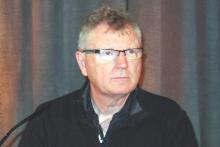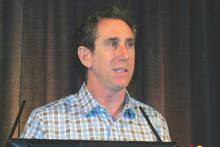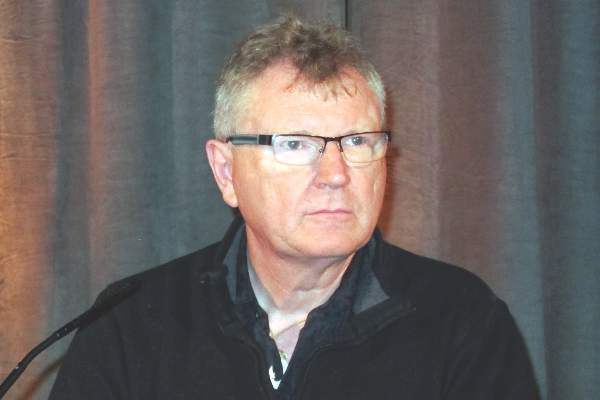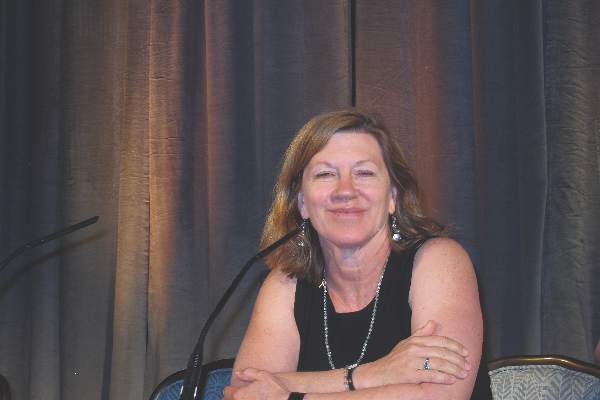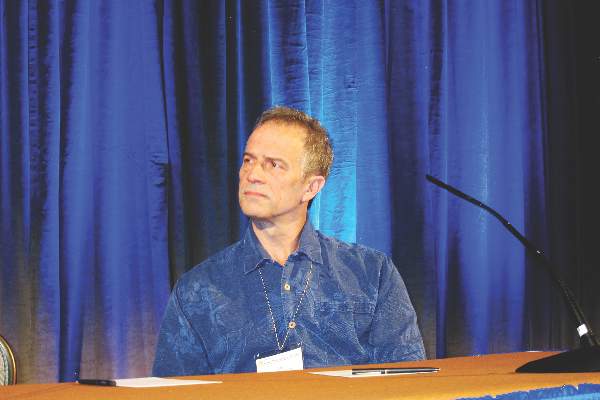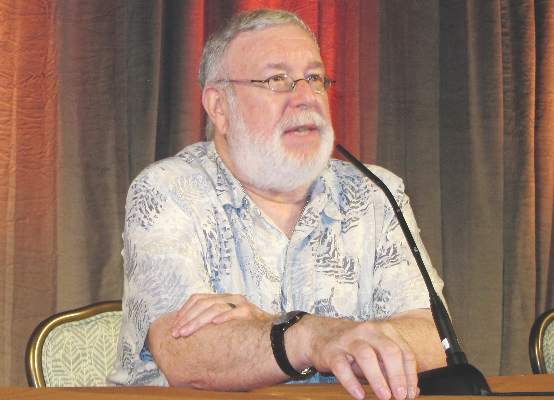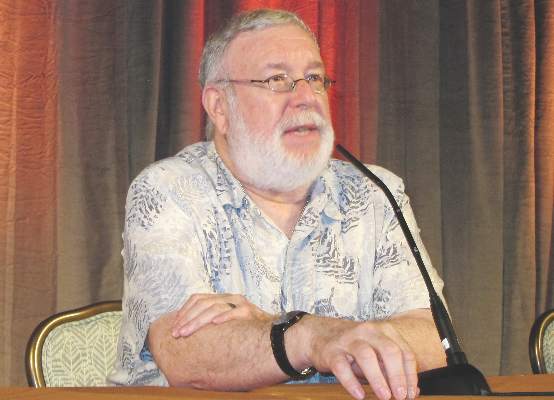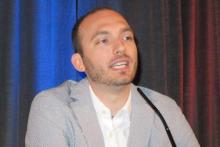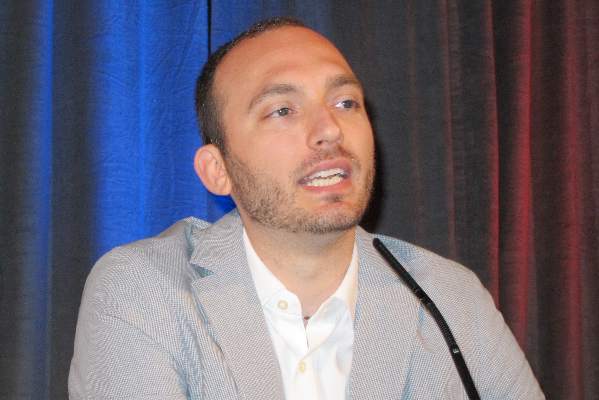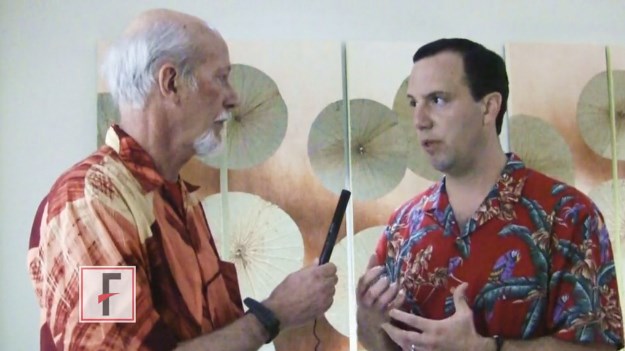User login
Intralesional interferon excels for challenging basal cell carcinomas
WAIKOLOA, HAWAII – Intralesional injection of interferon alfa-2b is an excellent option for the treatment of large problematic basal cell carcinomas in patients who aren’t interested in the higher-morbidity options, Dr. David L. Swanson said at the Hawaii Dermatology Seminar provided by Global Academy for Medical Education/Skin Disease Education Foundation.
“This is a really effective way to treat basal cell carcinomas. These things just melt away before your eyes. It’s really quite amazing,” observed Dr. Swanson of Mayo Clinic Scottsdale (Ariz.).
He finds this therapy particularly useful in frail elderly patients who have a large BCC on the head or neck. A good example would be an 89-year-old with multiple comorbid conditions who has a 2-cm BCC on the tip of the nose and doesn’t want anything done about it. The patient declines the options of Mohs micrographic surgery or radiotherapy.
“This is the patient who just wants to be left alone. That’s fine if they’re going to be dead within a year, but if they’re going to be around for several years, that basal cell carcinoma could become a major issue for them,” the dermatologist continued.
He and his colleagues at the Mayo Clinic follow a treatment regimen similar to one laid out by Turkish investigators more than a decade ago in one of the few long-term outcome studies of intralesional interferon for treatment of BCCs.
Although interferon alfa-2b is approved for the intralesional treatment of genital warts and subcutaneously for Kaposi’s sarcoma and malignant melanoma, among other conditions, it’s off-label therapy for BCCs. The treatment entails thrice-weekly intralesional injections for 3 weeks. The dosing is 1.5 million units per injection for BCCs smaller than 2 cm and 3 million units per injection for BCCs that are 2 cm or larger. The injections are given without anesthesia, but premedication with 500-1,000 mg of acetaminophen is advisable to minimize aches and fever.
Interferon alfa-2b (Intron A) comes in a vial containing 10 million units with 1 mL of diluent. It’s important to reconstitute it carefully, similar to onabotulinumtoxin. Don’t shake it, Dr. Swanson advised.
The Turkish report included 20 patients with histopathologically proven BCCs on the head or neck. At clinical and dermatopathologic follow-up 8 weeks after the last interferon injection, 11 BCCs showed complete clinical and histopathologic cure, six showed partial remission, two showed no response, and one actually increased in size during treatment.
The 11 patients with an initial complete cure were followed for 7 years. During that period, only one of the 11 skin cancers recurred, at the fifth year (Clin Drug Investig. 2005;25[10]:661-7).
Dr. Swanson reported having no financial conflicts regarding his presentation. SDEF and this news organization are owned by the same parent company.
WAIKOLOA, HAWAII – Intralesional injection of interferon alfa-2b is an excellent option for the treatment of large problematic basal cell carcinomas in patients who aren’t interested in the higher-morbidity options, Dr. David L. Swanson said at the Hawaii Dermatology Seminar provided by Global Academy for Medical Education/Skin Disease Education Foundation.
“This is a really effective way to treat basal cell carcinomas. These things just melt away before your eyes. It’s really quite amazing,” observed Dr. Swanson of Mayo Clinic Scottsdale (Ariz.).
He finds this therapy particularly useful in frail elderly patients who have a large BCC on the head or neck. A good example would be an 89-year-old with multiple comorbid conditions who has a 2-cm BCC on the tip of the nose and doesn’t want anything done about it. The patient declines the options of Mohs micrographic surgery or radiotherapy.
“This is the patient who just wants to be left alone. That’s fine if they’re going to be dead within a year, but if they’re going to be around for several years, that basal cell carcinoma could become a major issue for them,” the dermatologist continued.
He and his colleagues at the Mayo Clinic follow a treatment regimen similar to one laid out by Turkish investigators more than a decade ago in one of the few long-term outcome studies of intralesional interferon for treatment of BCCs.
Although interferon alfa-2b is approved for the intralesional treatment of genital warts and subcutaneously for Kaposi’s sarcoma and malignant melanoma, among other conditions, it’s off-label therapy for BCCs. The treatment entails thrice-weekly intralesional injections for 3 weeks. The dosing is 1.5 million units per injection for BCCs smaller than 2 cm and 3 million units per injection for BCCs that are 2 cm or larger. The injections are given without anesthesia, but premedication with 500-1,000 mg of acetaminophen is advisable to minimize aches and fever.
Interferon alfa-2b (Intron A) comes in a vial containing 10 million units with 1 mL of diluent. It’s important to reconstitute it carefully, similar to onabotulinumtoxin. Don’t shake it, Dr. Swanson advised.
The Turkish report included 20 patients with histopathologically proven BCCs on the head or neck. At clinical and dermatopathologic follow-up 8 weeks after the last interferon injection, 11 BCCs showed complete clinical and histopathologic cure, six showed partial remission, two showed no response, and one actually increased in size during treatment.
The 11 patients with an initial complete cure were followed for 7 years. During that period, only one of the 11 skin cancers recurred, at the fifth year (Clin Drug Investig. 2005;25[10]:661-7).
Dr. Swanson reported having no financial conflicts regarding his presentation. SDEF and this news organization are owned by the same parent company.
WAIKOLOA, HAWAII – Intralesional injection of interferon alfa-2b is an excellent option for the treatment of large problematic basal cell carcinomas in patients who aren’t interested in the higher-morbidity options, Dr. David L. Swanson said at the Hawaii Dermatology Seminar provided by Global Academy for Medical Education/Skin Disease Education Foundation.
“This is a really effective way to treat basal cell carcinomas. These things just melt away before your eyes. It’s really quite amazing,” observed Dr. Swanson of Mayo Clinic Scottsdale (Ariz.).
He finds this therapy particularly useful in frail elderly patients who have a large BCC on the head or neck. A good example would be an 89-year-old with multiple comorbid conditions who has a 2-cm BCC on the tip of the nose and doesn’t want anything done about it. The patient declines the options of Mohs micrographic surgery or radiotherapy.
“This is the patient who just wants to be left alone. That’s fine if they’re going to be dead within a year, but if they’re going to be around for several years, that basal cell carcinoma could become a major issue for them,” the dermatologist continued.
He and his colleagues at the Mayo Clinic follow a treatment regimen similar to one laid out by Turkish investigators more than a decade ago in one of the few long-term outcome studies of intralesional interferon for treatment of BCCs.
Although interferon alfa-2b is approved for the intralesional treatment of genital warts and subcutaneously for Kaposi’s sarcoma and malignant melanoma, among other conditions, it’s off-label therapy for BCCs. The treatment entails thrice-weekly intralesional injections for 3 weeks. The dosing is 1.5 million units per injection for BCCs smaller than 2 cm and 3 million units per injection for BCCs that are 2 cm or larger. The injections are given without anesthesia, but premedication with 500-1,000 mg of acetaminophen is advisable to minimize aches and fever.
Interferon alfa-2b (Intron A) comes in a vial containing 10 million units with 1 mL of diluent. It’s important to reconstitute it carefully, similar to onabotulinumtoxin. Don’t shake it, Dr. Swanson advised.
The Turkish report included 20 patients with histopathologically proven BCCs on the head or neck. At clinical and dermatopathologic follow-up 8 weeks after the last interferon injection, 11 BCCs showed complete clinical and histopathologic cure, six showed partial remission, two showed no response, and one actually increased in size during treatment.
The 11 patients with an initial complete cure were followed for 7 years. During that period, only one of the 11 skin cancers recurred, at the fifth year (Clin Drug Investig. 2005;25[10]:661-7).
Dr. Swanson reported having no financial conflicts regarding his presentation. SDEF and this news organization are owned by the same parent company.
EXPERT ANALYSIS FROM SDEF HAWAII DERMATOLOGY SEMINAR
Experts say topical retinoid still a winner for facial rejuvenation
WAIKOLOA, HAWAII – Have topical retinoids fallen by the wayside for treatment of facial wrinkles in this era of cosmeceuticals, spa facilities, lasers, and injectables?
Not by a long shot, a panel of experts in aesthetic dermatology agreed at the Hawaii Dermatology Seminar provided by Global Academy for Medical Education/Skin Disease Education Foundation.
“I think there’s an ethical issue here. When my patients come in for an assessment, I feel bound to say, ‘Look, we can do all these fancy procedures, lasers, and so forth, but if you use Retin-A for 6 months you’re going to see a nice improvement, so maybe you should try that first.’ It’s quite common that I’ll do that, although I prefer Tazorac [tazarotene] for a number of reasons,” said Dr. Christopher B. Zachary, professor and chair of the department of dermatology at the University of California, Irvine.
That being said, he added a caveat: “I couldn’t use a topical because I just don’t have it in me to put something on my face every night, but there are people who want that. I prefer a quick fix, like a laser.”
Dr. Suzanne L. Kilmer, director of the Laser and Skin Surgery Center of Northern California, Sacramento, declared, “I tell everybody, ‘Number one, I want you to block the sun. I believe only in the zinc oxide sunscreens because I want to block all the way up to 400 nm.’ ” And number two, she says that tretinoin and tazarotene are by far the most studied, and that “ ‘there are lots of great data that it helps not only with acne and wrinkles, but dysplastic nevi, actinic keratoses – it’s definitely a normalizer for your skin. You’ll get great results. And if you’re using that you’re probably going to get better results with any treatments I do.’ ”
Dr. Michael S. Kaminer, a partner in SkinCare Physicians in Chestnut Hill, Ma., said one thing that hasn’t changed over the years is that quite a few patients – especially those who are fair-skinned – can’t tolerate a topical retinoid on the face. They find it too irritating.
“I think it’s a lot of people. They just have a hard time with it,” observed Dr. Kaminer, also of Yale University in New Haven, Conn.
Asked if patients can get results comparable to Retin-A using OTC topical cosmeceuticals, Dr. Brooke C. Sikora, a dermatologist who also practices at SkinCare Physicians, said it’s tough to say because the studies that have been done were cosmeceutical-industry sponsored.
“Some of the industry-sponsored studies claim and show evidence that with some of the retinol products they can get near-tretinoin results. But you have to take that with a grain of salt,” she advised.
All of the speakers reported receiving grant support from and serving as consultants to various pharmaceutical companies. SDEF and this news organization are owned by the same parent company.
WAIKOLOA, HAWAII – Have topical retinoids fallen by the wayside for treatment of facial wrinkles in this era of cosmeceuticals, spa facilities, lasers, and injectables?
Not by a long shot, a panel of experts in aesthetic dermatology agreed at the Hawaii Dermatology Seminar provided by Global Academy for Medical Education/Skin Disease Education Foundation.
“I think there’s an ethical issue here. When my patients come in for an assessment, I feel bound to say, ‘Look, we can do all these fancy procedures, lasers, and so forth, but if you use Retin-A for 6 months you’re going to see a nice improvement, so maybe you should try that first.’ It’s quite common that I’ll do that, although I prefer Tazorac [tazarotene] for a number of reasons,” said Dr. Christopher B. Zachary, professor and chair of the department of dermatology at the University of California, Irvine.
That being said, he added a caveat: “I couldn’t use a topical because I just don’t have it in me to put something on my face every night, but there are people who want that. I prefer a quick fix, like a laser.”
Dr. Suzanne L. Kilmer, director of the Laser and Skin Surgery Center of Northern California, Sacramento, declared, “I tell everybody, ‘Number one, I want you to block the sun. I believe only in the zinc oxide sunscreens because I want to block all the way up to 400 nm.’ ” And number two, she says that tretinoin and tazarotene are by far the most studied, and that “ ‘there are lots of great data that it helps not only with acne and wrinkles, but dysplastic nevi, actinic keratoses – it’s definitely a normalizer for your skin. You’ll get great results. And if you’re using that you’re probably going to get better results with any treatments I do.’ ”
Dr. Michael S. Kaminer, a partner in SkinCare Physicians in Chestnut Hill, Ma., said one thing that hasn’t changed over the years is that quite a few patients – especially those who are fair-skinned – can’t tolerate a topical retinoid on the face. They find it too irritating.
“I think it’s a lot of people. They just have a hard time with it,” observed Dr. Kaminer, also of Yale University in New Haven, Conn.
Asked if patients can get results comparable to Retin-A using OTC topical cosmeceuticals, Dr. Brooke C. Sikora, a dermatologist who also practices at SkinCare Physicians, said it’s tough to say because the studies that have been done were cosmeceutical-industry sponsored.
“Some of the industry-sponsored studies claim and show evidence that with some of the retinol products they can get near-tretinoin results. But you have to take that with a grain of salt,” she advised.
All of the speakers reported receiving grant support from and serving as consultants to various pharmaceutical companies. SDEF and this news organization are owned by the same parent company.
WAIKOLOA, HAWAII – Have topical retinoids fallen by the wayside for treatment of facial wrinkles in this era of cosmeceuticals, spa facilities, lasers, and injectables?
Not by a long shot, a panel of experts in aesthetic dermatology agreed at the Hawaii Dermatology Seminar provided by Global Academy for Medical Education/Skin Disease Education Foundation.
“I think there’s an ethical issue here. When my patients come in for an assessment, I feel bound to say, ‘Look, we can do all these fancy procedures, lasers, and so forth, but if you use Retin-A for 6 months you’re going to see a nice improvement, so maybe you should try that first.’ It’s quite common that I’ll do that, although I prefer Tazorac [tazarotene] for a number of reasons,” said Dr. Christopher B. Zachary, professor and chair of the department of dermatology at the University of California, Irvine.
That being said, he added a caveat: “I couldn’t use a topical because I just don’t have it in me to put something on my face every night, but there are people who want that. I prefer a quick fix, like a laser.”
Dr. Suzanne L. Kilmer, director of the Laser and Skin Surgery Center of Northern California, Sacramento, declared, “I tell everybody, ‘Number one, I want you to block the sun. I believe only in the zinc oxide sunscreens because I want to block all the way up to 400 nm.’ ” And number two, she says that tretinoin and tazarotene are by far the most studied, and that “ ‘there are lots of great data that it helps not only with acne and wrinkles, but dysplastic nevi, actinic keratoses – it’s definitely a normalizer for your skin. You’ll get great results. And if you’re using that you’re probably going to get better results with any treatments I do.’ ”
Dr. Michael S. Kaminer, a partner in SkinCare Physicians in Chestnut Hill, Ma., said one thing that hasn’t changed over the years is that quite a few patients – especially those who are fair-skinned – can’t tolerate a topical retinoid on the face. They find it too irritating.
“I think it’s a lot of people. They just have a hard time with it,” observed Dr. Kaminer, also of Yale University in New Haven, Conn.
Asked if patients can get results comparable to Retin-A using OTC topical cosmeceuticals, Dr. Brooke C. Sikora, a dermatologist who also practices at SkinCare Physicians, said it’s tough to say because the studies that have been done were cosmeceutical-industry sponsored.
“Some of the industry-sponsored studies claim and show evidence that with some of the retinol products they can get near-tretinoin results. But you have to take that with a grain of salt,” she advised.
All of the speakers reported receiving grant support from and serving as consultants to various pharmaceutical companies. SDEF and this news organization are owned by the same parent company.
EXPERT ANALYSIS FROM SDEF HAWAII DERMATOLOGY SEMINAR
How to use cryolipolysis for reduction of double chin
WAIKOLOA, HAWAII – Patient interest is soaring in fat cell reduction via cryolipolysis using the noninvasive CoolSculpting technology, Dr. Suzanne L. Kilmer said at the Hawaii Dermatology Seminar provided by Global Academy for Medical Education/Skin Disease Education Foundation.
She was one of the developers of the “treatment to transformation” (T2T) approach to CoolSculpting, in which larger areas of fat deposits are safely treated per session than in the earliest days of the therapy’s availability.
“Treatment to transformation has been a home run. Our use of this approach has increased greatly in our practice because a lot of people don’t want to do liposuction, which has more risk and downtime. We’ve purchased a second device to accommodate patients and treat two areas at once, said Dr. Kilmer, director of the Laser and Skin Surgery Center of Northern California in Sacramento.
She was lead author of the pivotal trial which led to Food and Drug Administration clearance of Zeltiq Aesthetics’ CoolSculpting for treatment of submental fat. That’s the fifth body area for which FDA clearance has been obtained on the basis of solid evidence of safety and efficacy, the others being the inner thighs, outer thighs, flanks or love handles, and abdomen.
The pivotal trial included 60 patients who underwent CoolSculpting for a double chin, or submental fullness, using a prototype of the device known as the CoolMini submental applicator, a small-volume vacuum delivery cup. The patient’s double chin was placed in the applicator, then a 60-minute–long treatment cycle was delivered to that area at –10° C. An optional second treatment could be delivered 6 weeks later.
There were no procedure-related serious adverse events. Ultrasound assessment carried out 12 weeks after the final cryolipolysis treatment showed a mean 2-mm reduction in fat layer thickness. Eighty-three percent of patients declared themselves satisfied, 77% reported visible fat reduction, 77% reported that they felt their appearance had improved, 76% found the procedure comfortable, and 80% indicated they would recommend submental cryolipolysis to a friend (Lasers Surg Med. 2016 Jan;48[1]:3-13).
Dr. Kilmer noted that cryolipolysis has been cleared by the FDA for fat reduction since 2010. It works by inducing a delayed slow death of fat cells via apoptosis. There is no immediate effect and the noninvasive procedure involves no anesthetics. There is very little inflammation, discomfort, or downtime for recovery. The typical result is roughly a 20% loss in fat cells in treated areas.
She offered a couple of practical tips regarding cryolipolysis for reduction of submental fat. First, the entire targeted area of submental fat must be able to fit inside the applicator. And after successful cryolipolysis, any residual areas of fat cells will have to be targeted using injections of deoxycholic acid (Kybella), because a small pocket of submental fat won’t get sucked up into the CoolMini applicator. (Deoxycholic acid was approved by the FDA in 2015, for treating moderate to severe submental fat in adults.)
“Actually, we use both treatments together on most people. When they have a lot of fat we start out by killing it with cryolipolysis. Then when it gets smaller we trim it down with deoxycholic acid, often with a neuromodulator to deal with the platysmal bands,” Dr. Kilmer said.
She reported serving on medical advisory boards for Zeltiq and a handful of other dermatologic device companies and receiving research funding from half a dozen companies.
SDEF and this news organization are owned by the same parent company.
WAIKOLOA, HAWAII – Patient interest is soaring in fat cell reduction via cryolipolysis using the noninvasive CoolSculpting technology, Dr. Suzanne L. Kilmer said at the Hawaii Dermatology Seminar provided by Global Academy for Medical Education/Skin Disease Education Foundation.
She was one of the developers of the “treatment to transformation” (T2T) approach to CoolSculpting, in which larger areas of fat deposits are safely treated per session than in the earliest days of the therapy’s availability.
“Treatment to transformation has been a home run. Our use of this approach has increased greatly in our practice because a lot of people don’t want to do liposuction, which has more risk and downtime. We’ve purchased a second device to accommodate patients and treat two areas at once, said Dr. Kilmer, director of the Laser and Skin Surgery Center of Northern California in Sacramento.
She was lead author of the pivotal trial which led to Food and Drug Administration clearance of Zeltiq Aesthetics’ CoolSculpting for treatment of submental fat. That’s the fifth body area for which FDA clearance has been obtained on the basis of solid evidence of safety and efficacy, the others being the inner thighs, outer thighs, flanks or love handles, and abdomen.
The pivotal trial included 60 patients who underwent CoolSculpting for a double chin, or submental fullness, using a prototype of the device known as the CoolMini submental applicator, a small-volume vacuum delivery cup. The patient’s double chin was placed in the applicator, then a 60-minute–long treatment cycle was delivered to that area at –10° C. An optional second treatment could be delivered 6 weeks later.
There were no procedure-related serious adverse events. Ultrasound assessment carried out 12 weeks after the final cryolipolysis treatment showed a mean 2-mm reduction in fat layer thickness. Eighty-three percent of patients declared themselves satisfied, 77% reported visible fat reduction, 77% reported that they felt their appearance had improved, 76% found the procedure comfortable, and 80% indicated they would recommend submental cryolipolysis to a friend (Lasers Surg Med. 2016 Jan;48[1]:3-13).
Dr. Kilmer noted that cryolipolysis has been cleared by the FDA for fat reduction since 2010. It works by inducing a delayed slow death of fat cells via apoptosis. There is no immediate effect and the noninvasive procedure involves no anesthetics. There is very little inflammation, discomfort, or downtime for recovery. The typical result is roughly a 20% loss in fat cells in treated areas.
She offered a couple of practical tips regarding cryolipolysis for reduction of submental fat. First, the entire targeted area of submental fat must be able to fit inside the applicator. And after successful cryolipolysis, any residual areas of fat cells will have to be targeted using injections of deoxycholic acid (Kybella), because a small pocket of submental fat won’t get sucked up into the CoolMini applicator. (Deoxycholic acid was approved by the FDA in 2015, for treating moderate to severe submental fat in adults.)
“Actually, we use both treatments together on most people. When they have a lot of fat we start out by killing it with cryolipolysis. Then when it gets smaller we trim it down with deoxycholic acid, often with a neuromodulator to deal with the platysmal bands,” Dr. Kilmer said.
She reported serving on medical advisory boards for Zeltiq and a handful of other dermatologic device companies and receiving research funding from half a dozen companies.
SDEF and this news organization are owned by the same parent company.
WAIKOLOA, HAWAII – Patient interest is soaring in fat cell reduction via cryolipolysis using the noninvasive CoolSculpting technology, Dr. Suzanne L. Kilmer said at the Hawaii Dermatology Seminar provided by Global Academy for Medical Education/Skin Disease Education Foundation.
She was one of the developers of the “treatment to transformation” (T2T) approach to CoolSculpting, in which larger areas of fat deposits are safely treated per session than in the earliest days of the therapy’s availability.
“Treatment to transformation has been a home run. Our use of this approach has increased greatly in our practice because a lot of people don’t want to do liposuction, which has more risk and downtime. We’ve purchased a second device to accommodate patients and treat two areas at once, said Dr. Kilmer, director of the Laser and Skin Surgery Center of Northern California in Sacramento.
She was lead author of the pivotal trial which led to Food and Drug Administration clearance of Zeltiq Aesthetics’ CoolSculpting for treatment of submental fat. That’s the fifth body area for which FDA clearance has been obtained on the basis of solid evidence of safety and efficacy, the others being the inner thighs, outer thighs, flanks or love handles, and abdomen.
The pivotal trial included 60 patients who underwent CoolSculpting for a double chin, or submental fullness, using a prototype of the device known as the CoolMini submental applicator, a small-volume vacuum delivery cup. The patient’s double chin was placed in the applicator, then a 60-minute–long treatment cycle was delivered to that area at –10° C. An optional second treatment could be delivered 6 weeks later.
There were no procedure-related serious adverse events. Ultrasound assessment carried out 12 weeks after the final cryolipolysis treatment showed a mean 2-mm reduction in fat layer thickness. Eighty-three percent of patients declared themselves satisfied, 77% reported visible fat reduction, 77% reported that they felt their appearance had improved, 76% found the procedure comfortable, and 80% indicated they would recommend submental cryolipolysis to a friend (Lasers Surg Med. 2016 Jan;48[1]:3-13).
Dr. Kilmer noted that cryolipolysis has been cleared by the FDA for fat reduction since 2010. It works by inducing a delayed slow death of fat cells via apoptosis. There is no immediate effect and the noninvasive procedure involves no anesthetics. There is very little inflammation, discomfort, or downtime for recovery. The typical result is roughly a 20% loss in fat cells in treated areas.
She offered a couple of practical tips regarding cryolipolysis for reduction of submental fat. First, the entire targeted area of submental fat must be able to fit inside the applicator. And after successful cryolipolysis, any residual areas of fat cells will have to be targeted using injections of deoxycholic acid (Kybella), because a small pocket of submental fat won’t get sucked up into the CoolMini applicator. (Deoxycholic acid was approved by the FDA in 2015, for treating moderate to severe submental fat in adults.)
“Actually, we use both treatments together on most people. When they have a lot of fat we start out by killing it with cryolipolysis. Then when it gets smaller we trim it down with deoxycholic acid, often with a neuromodulator to deal with the platysmal bands,” Dr. Kilmer said.
She reported serving on medical advisory boards for Zeltiq and a handful of other dermatologic device companies and receiving research funding from half a dozen companies.
SDEF and this news organization are owned by the same parent company.
EXPERT ANALYSIS FROM SDEF HAWAII DERMATOLOGY SEMINAR
Master clinician shares ‘little black book’ of pediatric dermatology therapies
WAIKOLOA, HAWAII – Generations of master clinicians in dermatology have made a practice of accumulating personal collections of obscure, non–evidence-based therapies for use when standard treatments aren’t getting the job done for challenging conditions.
Sometimes these dermatologic masters share them, as in the ‘what to do when you don’t know what to do’ compendium in Shelley and Shelley’s classic textbook, Advanced Dermatologic Therapeutics.
At the Hawaii Dermatology Seminar, Dr. Robert Sidbury opened his own little black book and shared several such backup pediatric dermatology therapies. All are off label. Their mechanisms of benefit are unclear. Formal supporting evidence is sparse to none. Some are time-honored therapies; indeed, one is a variant of Vleminckx’s solution, a popular treatment for severe nodulocystic acne in 1880. But these are all treatments Dr. Sidbury has personally found to be successful on repeated occasions as second-, third-, and fourth-line therapies, and he said he knows of other pediatric dermatologists with similarly favorable experiences using these agents.
“These just might be something to reach for when you’re out of options otherwise,” he explained at the seminar provided by Global Academy for Medical Education/Skin Disease Education Foundation.
“The gist of this talk is to help you realize what a gold mine your own experience and judgment is in trying to treat patients whose condition is stubborn. Sometimes we have a natural resistance to wanting to try things such as we’re talking about here, where there isn’t any supporting evidence. But if you can wrap your mind around the safety – if you’re comfortable with that – then I would encourage you to be more adventuresome,” said Dr. Sidbury, chief of dermatology at Seattle Children’s Hospital.
Among his go-to, last-resort recommendations are the following:
Griseofulvin for cutaneous or oral lichen planus. “I use tinea dosing: 20 mg/day in two divided doses, up to a maximum of 500-1,000 mg/day. I tend to give it for 1-2 months. I don’t follow labs when using griseofulvin for tinea or lichen planus,” he said.
This treatment is cited in the Shelleys’ textbook as well as in a recent systematic review and meta-analysis (Am J Clin Dermatol. 2016 Feb;17[1]:11-22).
Ketotifen for intractable itching. Dr. Sidbury calls pruritus of this severity “rogue itching,” which is not uncommon in patients with plexiform neurofibromas, very large keloids, or epidermolysis bullosa. “I’ve found ketotifen to be incredibly helpful when absolutely nothing else seems to help,” he said.
Ketotifen, an oral antihistamine, is a histamine-1 blocker and mast cell stabilizer. It’s not approved by the Food and Drug Administration but is available from Canada. Dr. Sidbury said he has found Northwest Pharmacy easy to work with online. The cost through that online pharmacy is $52 per 250 mL.
The oral dosing is 0.05 mg/kg twice a day in children aged 6 months up to 3 years, and 1 mg twice a day in children aged 3 years and older. He and others have found ketotifen to be extremely safe. Side effects are uncommon and consist of minimal sleep disruption, irritability, flulike symptoms, and weight gain.
Topical tofacitinib for alopecia areata. Tofacitinib (Xeljanz) is an oral Janus kinase inhibitor (JAK) approved for the treatment of rheumatoid arthritis. Dr. Sidbury has a compounding pharmacy make topical tofacitinib 2% in a liposomal base, which achieves better penetration than Versabase. He recommends Chemistry Rx in Philadelphia for compounding.
“I have no financial interest, I’ve just found them incredibly helpful. The cost is $330 for 30 g. That’s not dirt cheap by a long shot, but I’ve looked into this for parents before I was aware of the Chemistry Rx option, and the cost was thousands and thousands of dollars when I tried to get it compounded in a local pharmacy that didn’t have the economy of scale,” he said.
Patients apply the topical JAK inhibitor twice daily. “I’ve probably got six or seven kids on topical JAK inhibitor therapy for alopecia areata, and I’ve seen responses in all of them after having pretty much exhausted everything else,” according to the dermatologist.
He said he obtains a baseline CBC, liver enzyme levels, serum creatinine, and lipid levels, repeating the lab tests every 2 weeks initially, then monthly.
Vleminckx’s solution. This is a truly old school therapy for severe nodulocystic acne when isotretinoin isn’t an option. True Vleminckx’s solution is a sulfurated lime solution that smells terrible and is hard to come by. The closest thing Dr. Sidbury has found without resort to a compounding pharmacy is available OTC on Amazon. Thankfully, it contains an odor-masking agent, he said. He has patients apply the solution twice daily for 20 minutes at a time every other day.
Tar for vitiligo and lichen sclerosis. Vitiligo is a condition with a long list of treatment options, many of which aren’t all that effective. Dr. Sidbury learned of V-tar for vitiligo from Dr. Peter Lio, a pediatric dermatologist at Northwestern University, Chicago, who prescribes it frequently for stubborn areas, such as the knees and ankles. V-tar is a 30% crude coal tar product that’s water soluble. Patients apply a small amount once per week, and wash it off after 6-8 hours. V-tar is available from Dermasave Labs, a compounding pharmacy in Pleasant Valley, N.Y., he said.
For cases of lichen sclerosus where potent topical corticosteroids and topical calcineurin inhibitors are ineffective, he turns to twice-daily 6% liquor carbonis detergens in Aquaphor. It has an excellent safety profile. Irritation is rare and can be prevented using a barrier cream.
Fluconazole for erythema annulare centrifugum. Dr. Sidbury has used this on multiple occasions when standard therapy with antihistamines, topical steroids, topical calcineurin inhibitors, and/or calcipotriene didn’t work. At 3-6 mg/kg per day for 4 weeks, and a maximum daily dose of fluconazole of 200 mg, he has typically obtained a rapid reduction in itching, and skin clearance in about a week, with a sustained benefit.
This is another off-label treatment with a good safety profile, which he also frequently uses on label for neonates with candidiasis, Dr. Sidbury noted.
He reported having no financial conflicts regarding any of these therapies. SDEF and this news organization are owned by the same parent company.
WAIKOLOA, HAWAII – Generations of master clinicians in dermatology have made a practice of accumulating personal collections of obscure, non–evidence-based therapies for use when standard treatments aren’t getting the job done for challenging conditions.
Sometimes these dermatologic masters share them, as in the ‘what to do when you don’t know what to do’ compendium in Shelley and Shelley’s classic textbook, Advanced Dermatologic Therapeutics.
At the Hawaii Dermatology Seminar, Dr. Robert Sidbury opened his own little black book and shared several such backup pediatric dermatology therapies. All are off label. Their mechanisms of benefit are unclear. Formal supporting evidence is sparse to none. Some are time-honored therapies; indeed, one is a variant of Vleminckx’s solution, a popular treatment for severe nodulocystic acne in 1880. But these are all treatments Dr. Sidbury has personally found to be successful on repeated occasions as second-, third-, and fourth-line therapies, and he said he knows of other pediatric dermatologists with similarly favorable experiences using these agents.
“These just might be something to reach for when you’re out of options otherwise,” he explained at the seminar provided by Global Academy for Medical Education/Skin Disease Education Foundation.
“The gist of this talk is to help you realize what a gold mine your own experience and judgment is in trying to treat patients whose condition is stubborn. Sometimes we have a natural resistance to wanting to try things such as we’re talking about here, where there isn’t any supporting evidence. But if you can wrap your mind around the safety – if you’re comfortable with that – then I would encourage you to be more adventuresome,” said Dr. Sidbury, chief of dermatology at Seattle Children’s Hospital.
Among his go-to, last-resort recommendations are the following:
Griseofulvin for cutaneous or oral lichen planus. “I use tinea dosing: 20 mg/day in two divided doses, up to a maximum of 500-1,000 mg/day. I tend to give it for 1-2 months. I don’t follow labs when using griseofulvin for tinea or lichen planus,” he said.
This treatment is cited in the Shelleys’ textbook as well as in a recent systematic review and meta-analysis (Am J Clin Dermatol. 2016 Feb;17[1]:11-22).
Ketotifen for intractable itching. Dr. Sidbury calls pruritus of this severity “rogue itching,” which is not uncommon in patients with plexiform neurofibromas, very large keloids, or epidermolysis bullosa. “I’ve found ketotifen to be incredibly helpful when absolutely nothing else seems to help,” he said.
Ketotifen, an oral antihistamine, is a histamine-1 blocker and mast cell stabilizer. It’s not approved by the Food and Drug Administration but is available from Canada. Dr. Sidbury said he has found Northwest Pharmacy easy to work with online. The cost through that online pharmacy is $52 per 250 mL.
The oral dosing is 0.05 mg/kg twice a day in children aged 6 months up to 3 years, and 1 mg twice a day in children aged 3 years and older. He and others have found ketotifen to be extremely safe. Side effects are uncommon and consist of minimal sleep disruption, irritability, flulike symptoms, and weight gain.
Topical tofacitinib for alopecia areata. Tofacitinib (Xeljanz) is an oral Janus kinase inhibitor (JAK) approved for the treatment of rheumatoid arthritis. Dr. Sidbury has a compounding pharmacy make topical tofacitinib 2% in a liposomal base, which achieves better penetration than Versabase. He recommends Chemistry Rx in Philadelphia for compounding.
“I have no financial interest, I’ve just found them incredibly helpful. The cost is $330 for 30 g. That’s not dirt cheap by a long shot, but I’ve looked into this for parents before I was aware of the Chemistry Rx option, and the cost was thousands and thousands of dollars when I tried to get it compounded in a local pharmacy that didn’t have the economy of scale,” he said.
Patients apply the topical JAK inhibitor twice daily. “I’ve probably got six or seven kids on topical JAK inhibitor therapy for alopecia areata, and I’ve seen responses in all of them after having pretty much exhausted everything else,” according to the dermatologist.
He said he obtains a baseline CBC, liver enzyme levels, serum creatinine, and lipid levels, repeating the lab tests every 2 weeks initially, then monthly.
Vleminckx’s solution. This is a truly old school therapy for severe nodulocystic acne when isotretinoin isn’t an option. True Vleminckx’s solution is a sulfurated lime solution that smells terrible and is hard to come by. The closest thing Dr. Sidbury has found without resort to a compounding pharmacy is available OTC on Amazon. Thankfully, it contains an odor-masking agent, he said. He has patients apply the solution twice daily for 20 minutes at a time every other day.
Tar for vitiligo and lichen sclerosis. Vitiligo is a condition with a long list of treatment options, many of which aren’t all that effective. Dr. Sidbury learned of V-tar for vitiligo from Dr. Peter Lio, a pediatric dermatologist at Northwestern University, Chicago, who prescribes it frequently for stubborn areas, such as the knees and ankles. V-tar is a 30% crude coal tar product that’s water soluble. Patients apply a small amount once per week, and wash it off after 6-8 hours. V-tar is available from Dermasave Labs, a compounding pharmacy in Pleasant Valley, N.Y., he said.
For cases of lichen sclerosus where potent topical corticosteroids and topical calcineurin inhibitors are ineffective, he turns to twice-daily 6% liquor carbonis detergens in Aquaphor. It has an excellent safety profile. Irritation is rare and can be prevented using a barrier cream.
Fluconazole for erythema annulare centrifugum. Dr. Sidbury has used this on multiple occasions when standard therapy with antihistamines, topical steroids, topical calcineurin inhibitors, and/or calcipotriene didn’t work. At 3-6 mg/kg per day for 4 weeks, and a maximum daily dose of fluconazole of 200 mg, he has typically obtained a rapid reduction in itching, and skin clearance in about a week, with a sustained benefit.
This is another off-label treatment with a good safety profile, which he also frequently uses on label for neonates with candidiasis, Dr. Sidbury noted.
He reported having no financial conflicts regarding any of these therapies. SDEF and this news organization are owned by the same parent company.
WAIKOLOA, HAWAII – Generations of master clinicians in dermatology have made a practice of accumulating personal collections of obscure, non–evidence-based therapies for use when standard treatments aren’t getting the job done for challenging conditions.
Sometimes these dermatologic masters share them, as in the ‘what to do when you don’t know what to do’ compendium in Shelley and Shelley’s classic textbook, Advanced Dermatologic Therapeutics.
At the Hawaii Dermatology Seminar, Dr. Robert Sidbury opened his own little black book and shared several such backup pediatric dermatology therapies. All are off label. Their mechanisms of benefit are unclear. Formal supporting evidence is sparse to none. Some are time-honored therapies; indeed, one is a variant of Vleminckx’s solution, a popular treatment for severe nodulocystic acne in 1880. But these are all treatments Dr. Sidbury has personally found to be successful on repeated occasions as second-, third-, and fourth-line therapies, and he said he knows of other pediatric dermatologists with similarly favorable experiences using these agents.
“These just might be something to reach for when you’re out of options otherwise,” he explained at the seminar provided by Global Academy for Medical Education/Skin Disease Education Foundation.
“The gist of this talk is to help you realize what a gold mine your own experience and judgment is in trying to treat patients whose condition is stubborn. Sometimes we have a natural resistance to wanting to try things such as we’re talking about here, where there isn’t any supporting evidence. But if you can wrap your mind around the safety – if you’re comfortable with that – then I would encourage you to be more adventuresome,” said Dr. Sidbury, chief of dermatology at Seattle Children’s Hospital.
Among his go-to, last-resort recommendations are the following:
Griseofulvin for cutaneous or oral lichen planus. “I use tinea dosing: 20 mg/day in two divided doses, up to a maximum of 500-1,000 mg/day. I tend to give it for 1-2 months. I don’t follow labs when using griseofulvin for tinea or lichen planus,” he said.
This treatment is cited in the Shelleys’ textbook as well as in a recent systematic review and meta-analysis (Am J Clin Dermatol. 2016 Feb;17[1]:11-22).
Ketotifen for intractable itching. Dr. Sidbury calls pruritus of this severity “rogue itching,” which is not uncommon in patients with plexiform neurofibromas, very large keloids, or epidermolysis bullosa. “I’ve found ketotifen to be incredibly helpful when absolutely nothing else seems to help,” he said.
Ketotifen, an oral antihistamine, is a histamine-1 blocker and mast cell stabilizer. It’s not approved by the Food and Drug Administration but is available from Canada. Dr. Sidbury said he has found Northwest Pharmacy easy to work with online. The cost through that online pharmacy is $52 per 250 mL.
The oral dosing is 0.05 mg/kg twice a day in children aged 6 months up to 3 years, and 1 mg twice a day in children aged 3 years and older. He and others have found ketotifen to be extremely safe. Side effects are uncommon and consist of minimal sleep disruption, irritability, flulike symptoms, and weight gain.
Topical tofacitinib for alopecia areata. Tofacitinib (Xeljanz) is an oral Janus kinase inhibitor (JAK) approved for the treatment of rheumatoid arthritis. Dr. Sidbury has a compounding pharmacy make topical tofacitinib 2% in a liposomal base, which achieves better penetration than Versabase. He recommends Chemistry Rx in Philadelphia for compounding.
“I have no financial interest, I’ve just found them incredibly helpful. The cost is $330 for 30 g. That’s not dirt cheap by a long shot, but I’ve looked into this for parents before I was aware of the Chemistry Rx option, and the cost was thousands and thousands of dollars when I tried to get it compounded in a local pharmacy that didn’t have the economy of scale,” he said.
Patients apply the topical JAK inhibitor twice daily. “I’ve probably got six or seven kids on topical JAK inhibitor therapy for alopecia areata, and I’ve seen responses in all of them after having pretty much exhausted everything else,” according to the dermatologist.
He said he obtains a baseline CBC, liver enzyme levels, serum creatinine, and lipid levels, repeating the lab tests every 2 weeks initially, then monthly.
Vleminckx’s solution. This is a truly old school therapy for severe nodulocystic acne when isotretinoin isn’t an option. True Vleminckx’s solution is a sulfurated lime solution that smells terrible and is hard to come by. The closest thing Dr. Sidbury has found without resort to a compounding pharmacy is available OTC on Amazon. Thankfully, it contains an odor-masking agent, he said. He has patients apply the solution twice daily for 20 minutes at a time every other day.
Tar for vitiligo and lichen sclerosis. Vitiligo is a condition with a long list of treatment options, many of which aren’t all that effective. Dr. Sidbury learned of V-tar for vitiligo from Dr. Peter Lio, a pediatric dermatologist at Northwestern University, Chicago, who prescribes it frequently for stubborn areas, such as the knees and ankles. V-tar is a 30% crude coal tar product that’s water soluble. Patients apply a small amount once per week, and wash it off after 6-8 hours. V-tar is available from Dermasave Labs, a compounding pharmacy in Pleasant Valley, N.Y., he said.
For cases of lichen sclerosus where potent topical corticosteroids and topical calcineurin inhibitors are ineffective, he turns to twice-daily 6% liquor carbonis detergens in Aquaphor. It has an excellent safety profile. Irritation is rare and can be prevented using a barrier cream.
Fluconazole for erythema annulare centrifugum. Dr. Sidbury has used this on multiple occasions when standard therapy with antihistamines, topical steroids, topical calcineurin inhibitors, and/or calcipotriene didn’t work. At 3-6 mg/kg per day for 4 weeks, and a maximum daily dose of fluconazole of 200 mg, he has typically obtained a rapid reduction in itching, and skin clearance in about a week, with a sustained benefit.
This is another off-label treatment with a good safety profile, which he also frequently uses on label for neonates with candidiasis, Dr. Sidbury noted.
He reported having no financial conflicts regarding any of these therapies. SDEF and this news organization are owned by the same parent company.
EXPERT ANALYSIS FROM SDEF HAWAII DERMATOLOGY SEMINAR
Don’t overlook topical tazarotene for psoriasis
WAIKOLOA, HAWAII – Tazarotene remains an important and effective albeit greatly underutilized topical therapy in psoriasis – but it’s on its way to becoming an even better drug, Dr. Linda Stein Gold said at the Hawaii Dermatology Seminar provided by the Global Academy for Medical Education/Skin Disease Education Foundation.
The topical retinoid has been formulated together with the superpotent steroid halobetasol propionate 0.01% in an investigational fixed combination lotion known for now as IDP-118. This medication, under development by Valeant, is in an ongoing, phase III multicenter, double-blind randomized trial with the vehicle lotion serving as control in adults with moderate to severe plaque psoriasis. A year-long, open-label, phase III safety study is also in progress, according to Dr. Stein Gold of Henry Ford Hospital in Detroit.
Tazarotene (Tazorac) is approved by the Food and Drug Administration as a 0.05% and 0.1% cream or gel for psoriasis and in the 0.1% cream or gel for acne. But when Dr. Stein Gold asked her large Hawaii audience for a show of hands as to who is prescribing tazarotene for their psoriasis patients, not a hand went up.
“Tazarotene carries some baggage,” she observed. “It’s pregnancy category X, and it also is quite irritating. If you use tazarotene on psoriatic skin, you’ll get a lot of irritation. But if you do so in combination with a potent or superpotent topical steroid, you’re not only able to increase the efficacy, but you also minimize the tolerability issues.
These dual benefits are the result of the two treatments’ differing mechanisms of action. This has been known for a long time. Indeed, it was demonstrated in a randomized trial nearly 2 decades ago (J Am Acad Dermatol. 1998 Oct;39[4 Pt 2]:S139-43). But only with the recent appreciation that 80% of psoriasis patients treat their disease exclusively with topical therapies has a pharmaceutical company moved to take advantage of these synergistic effects.
Dr. Stein Gold, director of dermatology research at Detroit’s Henry Ford Health System, said that the pharmaceutical industry has finally noted the considerable unmet need for additional topical psoriasis therapies that will be more effective and/or cosmetically elegant or have a novel mechanism of action. A slew of novel topical agents are now in the developmental pipeline in phase II studies for psoriasis. Among these new molecules are a topical formulation of methotrexate in a proprietary vehicle; the Janus kinase (JAK) 1 and 2 inhibitor ruxolitinib (Jakafi) in a cream for treatment of both psoriasis and atopic dermatitis; a tyrosine kinase inhibitor cream and ointment; an integrin inhibitor cream, and a phosphodiesterase-4 inhibitor ointment.
In addition, in October 2015, the FDA approved an aerosol foam fixed combination of calcipotriene 0.005% and betamethasone dipropionate 0.064% (Enstilar) for psoriasis. It’s more effective and cosmetically elegant than the fixed-combination ointment, she noted.
“Topical therapy is still going strong. I think there is always going to be a need for topical psoriasis therapies,” the dermatologist declared.
She reported serving as a consultant to and/or scientific advisory board member for numerous pharmaceutical companies.
SDEF and this news organization are owned by the same parent company.
WAIKOLOA, HAWAII – Tazarotene remains an important and effective albeit greatly underutilized topical therapy in psoriasis – but it’s on its way to becoming an even better drug, Dr. Linda Stein Gold said at the Hawaii Dermatology Seminar provided by the Global Academy for Medical Education/Skin Disease Education Foundation.
The topical retinoid has been formulated together with the superpotent steroid halobetasol propionate 0.01% in an investigational fixed combination lotion known for now as IDP-118. This medication, under development by Valeant, is in an ongoing, phase III multicenter, double-blind randomized trial with the vehicle lotion serving as control in adults with moderate to severe plaque psoriasis. A year-long, open-label, phase III safety study is also in progress, according to Dr. Stein Gold of Henry Ford Hospital in Detroit.
Tazarotene (Tazorac) is approved by the Food and Drug Administration as a 0.05% and 0.1% cream or gel for psoriasis and in the 0.1% cream or gel for acne. But when Dr. Stein Gold asked her large Hawaii audience for a show of hands as to who is prescribing tazarotene for their psoriasis patients, not a hand went up.
“Tazarotene carries some baggage,” she observed. “It’s pregnancy category X, and it also is quite irritating. If you use tazarotene on psoriatic skin, you’ll get a lot of irritation. But if you do so in combination with a potent or superpotent topical steroid, you’re not only able to increase the efficacy, but you also minimize the tolerability issues.
These dual benefits are the result of the two treatments’ differing mechanisms of action. This has been known for a long time. Indeed, it was demonstrated in a randomized trial nearly 2 decades ago (J Am Acad Dermatol. 1998 Oct;39[4 Pt 2]:S139-43). But only with the recent appreciation that 80% of psoriasis patients treat their disease exclusively with topical therapies has a pharmaceutical company moved to take advantage of these synergistic effects.
Dr. Stein Gold, director of dermatology research at Detroit’s Henry Ford Health System, said that the pharmaceutical industry has finally noted the considerable unmet need for additional topical psoriasis therapies that will be more effective and/or cosmetically elegant or have a novel mechanism of action. A slew of novel topical agents are now in the developmental pipeline in phase II studies for psoriasis. Among these new molecules are a topical formulation of methotrexate in a proprietary vehicle; the Janus kinase (JAK) 1 and 2 inhibitor ruxolitinib (Jakafi) in a cream for treatment of both psoriasis and atopic dermatitis; a tyrosine kinase inhibitor cream and ointment; an integrin inhibitor cream, and a phosphodiesterase-4 inhibitor ointment.
In addition, in October 2015, the FDA approved an aerosol foam fixed combination of calcipotriene 0.005% and betamethasone dipropionate 0.064% (Enstilar) for psoriasis. It’s more effective and cosmetically elegant than the fixed-combination ointment, she noted.
“Topical therapy is still going strong. I think there is always going to be a need for topical psoriasis therapies,” the dermatologist declared.
She reported serving as a consultant to and/or scientific advisory board member for numerous pharmaceutical companies.
SDEF and this news organization are owned by the same parent company.
WAIKOLOA, HAWAII – Tazarotene remains an important and effective albeit greatly underutilized topical therapy in psoriasis – but it’s on its way to becoming an even better drug, Dr. Linda Stein Gold said at the Hawaii Dermatology Seminar provided by the Global Academy for Medical Education/Skin Disease Education Foundation.
The topical retinoid has been formulated together with the superpotent steroid halobetasol propionate 0.01% in an investigational fixed combination lotion known for now as IDP-118. This medication, under development by Valeant, is in an ongoing, phase III multicenter, double-blind randomized trial with the vehicle lotion serving as control in adults with moderate to severe plaque psoriasis. A year-long, open-label, phase III safety study is also in progress, according to Dr. Stein Gold of Henry Ford Hospital in Detroit.
Tazarotene (Tazorac) is approved by the Food and Drug Administration as a 0.05% and 0.1% cream or gel for psoriasis and in the 0.1% cream or gel for acne. But when Dr. Stein Gold asked her large Hawaii audience for a show of hands as to who is prescribing tazarotene for their psoriasis patients, not a hand went up.
“Tazarotene carries some baggage,” she observed. “It’s pregnancy category X, and it also is quite irritating. If you use tazarotene on psoriatic skin, you’ll get a lot of irritation. But if you do so in combination with a potent or superpotent topical steroid, you’re not only able to increase the efficacy, but you also minimize the tolerability issues.
These dual benefits are the result of the two treatments’ differing mechanisms of action. This has been known for a long time. Indeed, it was demonstrated in a randomized trial nearly 2 decades ago (J Am Acad Dermatol. 1998 Oct;39[4 Pt 2]:S139-43). But only with the recent appreciation that 80% of psoriasis patients treat their disease exclusively with topical therapies has a pharmaceutical company moved to take advantage of these synergistic effects.
Dr. Stein Gold, director of dermatology research at Detroit’s Henry Ford Health System, said that the pharmaceutical industry has finally noted the considerable unmet need for additional topical psoriasis therapies that will be more effective and/or cosmetically elegant or have a novel mechanism of action. A slew of novel topical agents are now in the developmental pipeline in phase II studies for psoriasis. Among these new molecules are a topical formulation of methotrexate in a proprietary vehicle; the Janus kinase (JAK) 1 and 2 inhibitor ruxolitinib (Jakafi) in a cream for treatment of both psoriasis and atopic dermatitis; a tyrosine kinase inhibitor cream and ointment; an integrin inhibitor cream, and a phosphodiesterase-4 inhibitor ointment.
In addition, in October 2015, the FDA approved an aerosol foam fixed combination of calcipotriene 0.005% and betamethasone dipropionate 0.064% (Enstilar) for psoriasis. It’s more effective and cosmetically elegant than the fixed-combination ointment, she noted.
“Topical therapy is still going strong. I think there is always going to be a need for topical psoriasis therapies,” the dermatologist declared.
She reported serving as a consultant to and/or scientific advisory board member for numerous pharmaceutical companies.
SDEF and this news organization are owned by the same parent company.
EXPERT ANALYSIS FROM SDEF HAWAII DERMATOLOGY SEMINAR
When toenail onychomycosis can turn deadly
WAIKOLOA, HAWAII – Toenail onychomycosis is a common condition in the general population, but it’s three- to fourfold more prevalent in certain at risk populations where it can have serious and even life-threatening consequences, Dr. Theodore Rosen observed at the Hawaii Dermatology Seminar provided by the Global Academy for Medical Education/Skin Disease Education Foundation.
He cited a recent systematic review led by Dr. Aditya K. Gupta, professor of dermatology at the University of Toronto, whom Dr. Rosen hailed as one of the world’s great fungal disease authorities. Dr. Gupta and coworkers concluded that while the prevalence of dermatophyte toenail onychomycosis is 3.2% worldwide in the general population, it climbs to 8.8% in diabetics, 10.2% in psoriatics, 10.3% in the elderly, 11.9% in dialysis patients, 5.2% in renal transplant recipients, and 10.4% in HIV-positive individuals. The highest prevalence of onychomycosis due to non-dermatophyte molds was seen in psoriasis patients, at 2.5%, while elderly patients had the highest prevalence of onychomycosis caused by yeasts, at 6.1% (J Eur Acad Dermatol Venereol. 2015 Jun;29[6]:1039-44).
“Onychomycosis is especially important in those who are immunocompromised and immunosuppressed, for two reasons. One is that really odd organisms that aren’t Trichophyton rubrum or T. interdigitale can be involved: saprophytes like Scopulariopsis, Acremonium, Aspergillus, and Paecilomyces. And some of these saprophytes, like Fusarium, can get from the nail and nail bed into the bloodstream and can kill,” explained Dr. Rosen, professor of dermatology at Baylor College of Medicine in Houston.
“Onychomycosis, aside from the fact that it looks bad and often leads to pain, can also lead to breaks in the skin which then result in secondary bacterial infections. In fact, after motor vehicle accidents, onychomycosis and tinea pedis combined are the most common cause of lower extremity cellulitis leading to hospitalization in the United States,” he continued.
The go-to treatments for onychomycosis in patients with a bad prognostic factor are oral itraconazole (Sporanox) and terbinafine. Don’t be unduly swayed by the complete cure rates reported in clinical trials and cited in the product package inserts; they don’t tell the full story because of important differences in study design, according to Dr. Rosen.
He recommended that physicians familiarize themselves with posaconazole (Noxafil) as an antifungal to consider for second-line therapy in difficult-to-cure cases of onychomycosis in immunosuppressed patients. This is off-label therapy. The approved indications for this triazole antifungal agent are prophylaxis of invasive Aspergillus and Candida infections in severely immunocompromised patients, as well as treatment of oropharyngeal candidiasis. But this is a potent agent that provides broad-spectrum coverage coupled with a favorable safety profile. It performed well in a phase IIb randomized, placebo- and active-controlled, multicenter, investigator-blinded study of 218 adults with toenail onychomycosis (Br J Dermatol. 2012 Feb;166[2]:389-98).
Dr. Rosen reported serving on scientific advisory boards for Anacor, Merz, and Valeant.
SDEF and this news organization are owned by the same parent company.
WAIKOLOA, HAWAII – Toenail onychomycosis is a common condition in the general population, but it’s three- to fourfold more prevalent in certain at risk populations where it can have serious and even life-threatening consequences, Dr. Theodore Rosen observed at the Hawaii Dermatology Seminar provided by the Global Academy for Medical Education/Skin Disease Education Foundation.
He cited a recent systematic review led by Dr. Aditya K. Gupta, professor of dermatology at the University of Toronto, whom Dr. Rosen hailed as one of the world’s great fungal disease authorities. Dr. Gupta and coworkers concluded that while the prevalence of dermatophyte toenail onychomycosis is 3.2% worldwide in the general population, it climbs to 8.8% in diabetics, 10.2% in psoriatics, 10.3% in the elderly, 11.9% in dialysis patients, 5.2% in renal transplant recipients, and 10.4% in HIV-positive individuals. The highest prevalence of onychomycosis due to non-dermatophyte molds was seen in psoriasis patients, at 2.5%, while elderly patients had the highest prevalence of onychomycosis caused by yeasts, at 6.1% (J Eur Acad Dermatol Venereol. 2015 Jun;29[6]:1039-44).
“Onychomycosis is especially important in those who are immunocompromised and immunosuppressed, for two reasons. One is that really odd organisms that aren’t Trichophyton rubrum or T. interdigitale can be involved: saprophytes like Scopulariopsis, Acremonium, Aspergillus, and Paecilomyces. And some of these saprophytes, like Fusarium, can get from the nail and nail bed into the bloodstream and can kill,” explained Dr. Rosen, professor of dermatology at Baylor College of Medicine in Houston.
“Onychomycosis, aside from the fact that it looks bad and often leads to pain, can also lead to breaks in the skin which then result in secondary bacterial infections. In fact, after motor vehicle accidents, onychomycosis and tinea pedis combined are the most common cause of lower extremity cellulitis leading to hospitalization in the United States,” he continued.
The go-to treatments for onychomycosis in patients with a bad prognostic factor are oral itraconazole (Sporanox) and terbinafine. Don’t be unduly swayed by the complete cure rates reported in clinical trials and cited in the product package inserts; they don’t tell the full story because of important differences in study design, according to Dr. Rosen.
He recommended that physicians familiarize themselves with posaconazole (Noxafil) as an antifungal to consider for second-line therapy in difficult-to-cure cases of onychomycosis in immunosuppressed patients. This is off-label therapy. The approved indications for this triazole antifungal agent are prophylaxis of invasive Aspergillus and Candida infections in severely immunocompromised patients, as well as treatment of oropharyngeal candidiasis. But this is a potent agent that provides broad-spectrum coverage coupled with a favorable safety profile. It performed well in a phase IIb randomized, placebo- and active-controlled, multicenter, investigator-blinded study of 218 adults with toenail onychomycosis (Br J Dermatol. 2012 Feb;166[2]:389-98).
Dr. Rosen reported serving on scientific advisory boards for Anacor, Merz, and Valeant.
SDEF and this news organization are owned by the same parent company.
WAIKOLOA, HAWAII – Toenail onychomycosis is a common condition in the general population, but it’s three- to fourfold more prevalent in certain at risk populations where it can have serious and even life-threatening consequences, Dr. Theodore Rosen observed at the Hawaii Dermatology Seminar provided by the Global Academy for Medical Education/Skin Disease Education Foundation.
He cited a recent systematic review led by Dr. Aditya K. Gupta, professor of dermatology at the University of Toronto, whom Dr. Rosen hailed as one of the world’s great fungal disease authorities. Dr. Gupta and coworkers concluded that while the prevalence of dermatophyte toenail onychomycosis is 3.2% worldwide in the general population, it climbs to 8.8% in diabetics, 10.2% in psoriatics, 10.3% in the elderly, 11.9% in dialysis patients, 5.2% in renal transplant recipients, and 10.4% in HIV-positive individuals. The highest prevalence of onychomycosis due to non-dermatophyte molds was seen in psoriasis patients, at 2.5%, while elderly patients had the highest prevalence of onychomycosis caused by yeasts, at 6.1% (J Eur Acad Dermatol Venereol. 2015 Jun;29[6]:1039-44).
“Onychomycosis is especially important in those who are immunocompromised and immunosuppressed, for two reasons. One is that really odd organisms that aren’t Trichophyton rubrum or T. interdigitale can be involved: saprophytes like Scopulariopsis, Acremonium, Aspergillus, and Paecilomyces. And some of these saprophytes, like Fusarium, can get from the nail and nail bed into the bloodstream and can kill,” explained Dr. Rosen, professor of dermatology at Baylor College of Medicine in Houston.
“Onychomycosis, aside from the fact that it looks bad and often leads to pain, can also lead to breaks in the skin which then result in secondary bacterial infections. In fact, after motor vehicle accidents, onychomycosis and tinea pedis combined are the most common cause of lower extremity cellulitis leading to hospitalization in the United States,” he continued.
The go-to treatments for onychomycosis in patients with a bad prognostic factor are oral itraconazole (Sporanox) and terbinafine. Don’t be unduly swayed by the complete cure rates reported in clinical trials and cited in the product package inserts; they don’t tell the full story because of important differences in study design, according to Dr. Rosen.
He recommended that physicians familiarize themselves with posaconazole (Noxafil) as an antifungal to consider for second-line therapy in difficult-to-cure cases of onychomycosis in immunosuppressed patients. This is off-label therapy. The approved indications for this triazole antifungal agent are prophylaxis of invasive Aspergillus and Candida infections in severely immunocompromised patients, as well as treatment of oropharyngeal candidiasis. But this is a potent agent that provides broad-spectrum coverage coupled with a favorable safety profile. It performed well in a phase IIb randomized, placebo- and active-controlled, multicenter, investigator-blinded study of 218 adults with toenail onychomycosis (Br J Dermatol. 2012 Feb;166[2]:389-98).
Dr. Rosen reported serving on scientific advisory boards for Anacor, Merz, and Valeant.
SDEF and this news organization are owned by the same parent company.
EXPERT ANALYSIS FROM SDEF HAWAII DERMATOLOGY SEMINAR
Itraconazole targets basal cell carcinoma
WAIKOLOA, HAWAII – The familiar oral triazole antifungal agent itraconazole (Sporanox) is under active investigation for an unexpected use: as adjunctive therapy in patients with locally advanced or metastatic basal cell carcinoma.
“The promise of this drug is that the use of itraconazole with vismodegib or sonidegib may actually enhance the effectiveness of those drugs and also reduce the frequency of grade 2 toxicities by perhaps allowing a lower dose of vismodegib or sonidegib,” Dr. David L. Swanson said at the Hawaii Dermatology Seminar provided by the Global Academy for Medical Education/Skin Disease Education Foundation.
“Be looking for this drug that we use to treat toenail fungus as a potential drug for locally advanced or metastatic basal cell carcinoma,” advised Dr. Swanson, a dermatologist at the Mayo Clinic in Scottsdale, Ariz.
Vismodegib (Erivedge) has been a game changer for patients with inoperable locally advanced or metastatic breast cancer. “The response to this drug was amazing,” Dr. Swanson said of the landmark study which led to its approval in 2012 (N Engl J Med. 2012; 366[23]:2171-9).
Sonidegib (Odomzo), which like vismodegib inhibits the essential Hedgehog signaling pathway component known as Smoothened, was approved by the Food and Drug Administration in 2015 as the second oral drug in this novel class.
While the clinical benefits of these two drugs in patients with the most horrific basal cell carcinomas are extremely impressive, vismodegib and sonidegib have two major drawbacks: The tumors eventually develop resistance and commence growing again, and onerous grade 2 side effects requiring dose reduction are extremely common. The most frequent of these limiting side effects are a disturbed sense of taste, muscle spasms, alopecia, and weight loss.
The hope is that itraconazole may be of help with both issues, according to Dr. Swanson. It turns out that the antifungal agent is also an inhibitor of the Hedgehog pathway, and via a different mechanism than that of vismodegib and sonidegib.
He pointed to an international open-label exploratory phase II study led by Dr. Jean Y. Tang of Stanford (Calif.) University. The investigators treated 19 patients with a total of 90 basal cell carcinomas with oral itraconazole at 200 mg twice a day for 1 month or 100 mg twice a day for an average of 2.3 months.
The treatment reduced Hedgehog signaling pathway activity by 65%, Ki67 tumor cell proliferation by 45%, and tumor area by 24% (J Clin Oncol. 2014 Mar 10;32[8]:745-51).
These results aren’t as dramatic as what’s achieved using vismodegib or sonidegib. As stand-alone therapy, itraconazole doesn’t compare with those agents. However, the hope is that when itraconazole is prescribed in conjunction with vismodegib or sonidegib it will permit the latter drugs to be used at lower doses with no drop-off in efficacy, which would mean less grade 2 toxicity. Moreover, since itraconazole inhibits Hedgehog signaling through a mechanism that is different from that of the more potent agents, combination therapy might delay onset of tumor resistance, Dr. Swanson explained.
He reported having no financial conflicts of interest regarding his presentation.
SDEF and this news organization are owned by the same parent company.
WAIKOLOA, HAWAII – The familiar oral triazole antifungal agent itraconazole (Sporanox) is under active investigation for an unexpected use: as adjunctive therapy in patients with locally advanced or metastatic basal cell carcinoma.
“The promise of this drug is that the use of itraconazole with vismodegib or sonidegib may actually enhance the effectiveness of those drugs and also reduce the frequency of grade 2 toxicities by perhaps allowing a lower dose of vismodegib or sonidegib,” Dr. David L. Swanson said at the Hawaii Dermatology Seminar provided by the Global Academy for Medical Education/Skin Disease Education Foundation.
“Be looking for this drug that we use to treat toenail fungus as a potential drug for locally advanced or metastatic basal cell carcinoma,” advised Dr. Swanson, a dermatologist at the Mayo Clinic in Scottsdale, Ariz.
Vismodegib (Erivedge) has been a game changer for patients with inoperable locally advanced or metastatic breast cancer. “The response to this drug was amazing,” Dr. Swanson said of the landmark study which led to its approval in 2012 (N Engl J Med. 2012; 366[23]:2171-9).
Sonidegib (Odomzo), which like vismodegib inhibits the essential Hedgehog signaling pathway component known as Smoothened, was approved by the Food and Drug Administration in 2015 as the second oral drug in this novel class.
While the clinical benefits of these two drugs in patients with the most horrific basal cell carcinomas are extremely impressive, vismodegib and sonidegib have two major drawbacks: The tumors eventually develop resistance and commence growing again, and onerous grade 2 side effects requiring dose reduction are extremely common. The most frequent of these limiting side effects are a disturbed sense of taste, muscle spasms, alopecia, and weight loss.
The hope is that itraconazole may be of help with both issues, according to Dr. Swanson. It turns out that the antifungal agent is also an inhibitor of the Hedgehog pathway, and via a different mechanism than that of vismodegib and sonidegib.
He pointed to an international open-label exploratory phase II study led by Dr. Jean Y. Tang of Stanford (Calif.) University. The investigators treated 19 patients with a total of 90 basal cell carcinomas with oral itraconazole at 200 mg twice a day for 1 month or 100 mg twice a day for an average of 2.3 months.
The treatment reduced Hedgehog signaling pathway activity by 65%, Ki67 tumor cell proliferation by 45%, and tumor area by 24% (J Clin Oncol. 2014 Mar 10;32[8]:745-51).
These results aren’t as dramatic as what’s achieved using vismodegib or sonidegib. As stand-alone therapy, itraconazole doesn’t compare with those agents. However, the hope is that when itraconazole is prescribed in conjunction with vismodegib or sonidegib it will permit the latter drugs to be used at lower doses with no drop-off in efficacy, which would mean less grade 2 toxicity. Moreover, since itraconazole inhibits Hedgehog signaling through a mechanism that is different from that of the more potent agents, combination therapy might delay onset of tumor resistance, Dr. Swanson explained.
He reported having no financial conflicts of interest regarding his presentation.
SDEF and this news organization are owned by the same parent company.
WAIKOLOA, HAWAII – The familiar oral triazole antifungal agent itraconazole (Sporanox) is under active investigation for an unexpected use: as adjunctive therapy in patients with locally advanced or metastatic basal cell carcinoma.
“The promise of this drug is that the use of itraconazole with vismodegib or sonidegib may actually enhance the effectiveness of those drugs and also reduce the frequency of grade 2 toxicities by perhaps allowing a lower dose of vismodegib or sonidegib,” Dr. David L. Swanson said at the Hawaii Dermatology Seminar provided by the Global Academy for Medical Education/Skin Disease Education Foundation.
“Be looking for this drug that we use to treat toenail fungus as a potential drug for locally advanced or metastatic basal cell carcinoma,” advised Dr. Swanson, a dermatologist at the Mayo Clinic in Scottsdale, Ariz.
Vismodegib (Erivedge) has been a game changer for patients with inoperable locally advanced or metastatic breast cancer. “The response to this drug was amazing,” Dr. Swanson said of the landmark study which led to its approval in 2012 (N Engl J Med. 2012; 366[23]:2171-9).
Sonidegib (Odomzo), which like vismodegib inhibits the essential Hedgehog signaling pathway component known as Smoothened, was approved by the Food and Drug Administration in 2015 as the second oral drug in this novel class.
While the clinical benefits of these two drugs in patients with the most horrific basal cell carcinomas are extremely impressive, vismodegib and sonidegib have two major drawbacks: The tumors eventually develop resistance and commence growing again, and onerous grade 2 side effects requiring dose reduction are extremely common. The most frequent of these limiting side effects are a disturbed sense of taste, muscle spasms, alopecia, and weight loss.
The hope is that itraconazole may be of help with both issues, according to Dr. Swanson. It turns out that the antifungal agent is also an inhibitor of the Hedgehog pathway, and via a different mechanism than that of vismodegib and sonidegib.
He pointed to an international open-label exploratory phase II study led by Dr. Jean Y. Tang of Stanford (Calif.) University. The investigators treated 19 patients with a total of 90 basal cell carcinomas with oral itraconazole at 200 mg twice a day for 1 month or 100 mg twice a day for an average of 2.3 months.
The treatment reduced Hedgehog signaling pathway activity by 65%, Ki67 tumor cell proliferation by 45%, and tumor area by 24% (J Clin Oncol. 2014 Mar 10;32[8]:745-51).
These results aren’t as dramatic as what’s achieved using vismodegib or sonidegib. As stand-alone therapy, itraconazole doesn’t compare with those agents. However, the hope is that when itraconazole is prescribed in conjunction with vismodegib or sonidegib it will permit the latter drugs to be used at lower doses with no drop-off in efficacy, which would mean less grade 2 toxicity. Moreover, since itraconazole inhibits Hedgehog signaling through a mechanism that is different from that of the more potent agents, combination therapy might delay onset of tumor resistance, Dr. Swanson explained.
He reported having no financial conflicts of interest regarding his presentation.
SDEF and this news organization are owned by the same parent company.
EXPERT ANALYSIS FROM SDEF HAWAII DERMATOLOGY SEMINAR
Maximizing bang in topical onychomycosis therapy
WAIKOLOA, HAWAII – Two recent studies highlight several key points regarding topical therapy for onychomycosis: Treat it early for best results, and if concomitant tinea pedis is present, be sure to treat that, too, Dr. Theodore Rosen said at the Hawaii Dermatology Seminar.
The studies were separate secondary analyses of the pooled results of two large, double blind, vehicle-controlled, 48-week, phase III randomized trials of efinaconazole 10% topical solution (Jublia) for onychomycosis. But the same lessons probably apply to any topical antifungal, according to Dr. Rosen, professor of dermatology at Baylor College of Medicine, Houston.
Early treatment: This makes a big difference in outcome, as demonstrated in Dr. Phoebe Rich’s analysis of 1,655 patients in the phase III studies. Dr. Rich, director of the nail disorders clinic at Oregon Health and Science University, Portland, divided participants into three groups based upon disease duration: less than a year, 1-5 years, or more than 5 years. The complete cure rate was much better in the group with less than 1 year of onychomycosis, even though the extent of nail involvement of the target toenail didn’t differ significantly between the three groups (J Drugs Dermatol. 2015;Jan 14[1]:58-62).
“Now we have data: Don’t wait to treat until it has been there for 35 years. It’s easier to treat if it’s early,” Dr. Rosen commented at the seminar provided by Global Academy for Medical Education/Skin Disease Education Foundation.
When onychomycosis and tinea pedis coexist, treat both: Dr. Leon H. Kircik of Indiana University, Indianapolis, and associates reported in a poster at the Hawaii Dermatology Seminar that one in five participants in the two phase III trials had tinea pedis as well as onychomycosis, and nearly half of them were treated for their athlete’s foot using their physician’s choice of topical antifungals.
The primary endpoint in the two trials was the week 53 complete cure rate, defined as no clinical involvement of the target toenail, a negative potassium hydroxide exam, and a negative fungal culture. Among subjects with concomitant onychomycosis and tinea pedis, the onychomycosis complete cure rate was 28.2% if they received efinaconazole for their onychomycosis and got treatment for their tinea pedis, compared with 20.9% if they got efinaconazole but no treatment for their tinea pedis. The complete/almost complete cure rate was 35.5% with dual therapy versus 29.6% if they only received efinaconazole. Both differences were significant.
“Doesn’t that make logical sense? If you leave the fungus on the foot or between the toes, it’s going to say, ‘Wow, that’s steak up there on the nail. That’s real food. I’m just going to crawl back onto the nail because all my brothers up there are dead and there’s wide-open space,” Dr. Rosen explained.
He added that the reverse is also true: if a patient presents seeking treatment for athlete’s foot but also has onychomycosis, the best treatment results for the tinea pedis are obtained by also treating the nail infection.
Dr. Rosen offered a money-saving tip for effective OTC therapy for tinea pedis. Two words: Lotrimin Ultra. That’s the brand name for butenafine cream 1%, not to be confused with plain old Lotrimin, which is clotrimazole.
“Clotrimazole has been around since the dawn of man, and it’s not very effective. Many of the fungi are actually resistant to it. But they’re not resistant to butenafine, which is a very good topical antifungal now available over the counter. It costs $9 or $10 dollars for a tube the size of a baseball bat. It’s a good, effective, cheap way of treating concomitant tinea pedis,” he said.
Dr. Rosen reported serving on scientific advisory boards for Anacor, Merz, and Valeant.
SDEF and this news organization are owned by the same parent company.
WAIKOLOA, HAWAII – Two recent studies highlight several key points regarding topical therapy for onychomycosis: Treat it early for best results, and if concomitant tinea pedis is present, be sure to treat that, too, Dr. Theodore Rosen said at the Hawaii Dermatology Seminar.
The studies were separate secondary analyses of the pooled results of two large, double blind, vehicle-controlled, 48-week, phase III randomized trials of efinaconazole 10% topical solution (Jublia) for onychomycosis. But the same lessons probably apply to any topical antifungal, according to Dr. Rosen, professor of dermatology at Baylor College of Medicine, Houston.
Early treatment: This makes a big difference in outcome, as demonstrated in Dr. Phoebe Rich’s analysis of 1,655 patients in the phase III studies. Dr. Rich, director of the nail disorders clinic at Oregon Health and Science University, Portland, divided participants into three groups based upon disease duration: less than a year, 1-5 years, or more than 5 years. The complete cure rate was much better in the group with less than 1 year of onychomycosis, even though the extent of nail involvement of the target toenail didn’t differ significantly between the three groups (J Drugs Dermatol. 2015;Jan 14[1]:58-62).
“Now we have data: Don’t wait to treat until it has been there for 35 years. It’s easier to treat if it’s early,” Dr. Rosen commented at the seminar provided by Global Academy for Medical Education/Skin Disease Education Foundation.
When onychomycosis and tinea pedis coexist, treat both: Dr. Leon H. Kircik of Indiana University, Indianapolis, and associates reported in a poster at the Hawaii Dermatology Seminar that one in five participants in the two phase III trials had tinea pedis as well as onychomycosis, and nearly half of them were treated for their athlete’s foot using their physician’s choice of topical antifungals.
The primary endpoint in the two trials was the week 53 complete cure rate, defined as no clinical involvement of the target toenail, a negative potassium hydroxide exam, and a negative fungal culture. Among subjects with concomitant onychomycosis and tinea pedis, the onychomycosis complete cure rate was 28.2% if they received efinaconazole for their onychomycosis and got treatment for their tinea pedis, compared with 20.9% if they got efinaconazole but no treatment for their tinea pedis. The complete/almost complete cure rate was 35.5% with dual therapy versus 29.6% if they only received efinaconazole. Both differences were significant.
“Doesn’t that make logical sense? If you leave the fungus on the foot or between the toes, it’s going to say, ‘Wow, that’s steak up there on the nail. That’s real food. I’m just going to crawl back onto the nail because all my brothers up there are dead and there’s wide-open space,” Dr. Rosen explained.
He added that the reverse is also true: if a patient presents seeking treatment for athlete’s foot but also has onychomycosis, the best treatment results for the tinea pedis are obtained by also treating the nail infection.
Dr. Rosen offered a money-saving tip for effective OTC therapy for tinea pedis. Two words: Lotrimin Ultra. That’s the brand name for butenafine cream 1%, not to be confused with plain old Lotrimin, which is clotrimazole.
“Clotrimazole has been around since the dawn of man, and it’s not very effective. Many of the fungi are actually resistant to it. But they’re not resistant to butenafine, which is a very good topical antifungal now available over the counter. It costs $9 or $10 dollars for a tube the size of a baseball bat. It’s a good, effective, cheap way of treating concomitant tinea pedis,” he said.
Dr. Rosen reported serving on scientific advisory boards for Anacor, Merz, and Valeant.
SDEF and this news organization are owned by the same parent company.
WAIKOLOA, HAWAII – Two recent studies highlight several key points regarding topical therapy for onychomycosis: Treat it early for best results, and if concomitant tinea pedis is present, be sure to treat that, too, Dr. Theodore Rosen said at the Hawaii Dermatology Seminar.
The studies were separate secondary analyses of the pooled results of two large, double blind, vehicle-controlled, 48-week, phase III randomized trials of efinaconazole 10% topical solution (Jublia) for onychomycosis. But the same lessons probably apply to any topical antifungal, according to Dr. Rosen, professor of dermatology at Baylor College of Medicine, Houston.
Early treatment: This makes a big difference in outcome, as demonstrated in Dr. Phoebe Rich’s analysis of 1,655 patients in the phase III studies. Dr. Rich, director of the nail disorders clinic at Oregon Health and Science University, Portland, divided participants into three groups based upon disease duration: less than a year, 1-5 years, or more than 5 years. The complete cure rate was much better in the group with less than 1 year of onychomycosis, even though the extent of nail involvement of the target toenail didn’t differ significantly between the three groups (J Drugs Dermatol. 2015;Jan 14[1]:58-62).
“Now we have data: Don’t wait to treat until it has been there for 35 years. It’s easier to treat if it’s early,” Dr. Rosen commented at the seminar provided by Global Academy for Medical Education/Skin Disease Education Foundation.
When onychomycosis and tinea pedis coexist, treat both: Dr. Leon H. Kircik of Indiana University, Indianapolis, and associates reported in a poster at the Hawaii Dermatology Seminar that one in five participants in the two phase III trials had tinea pedis as well as onychomycosis, and nearly half of them were treated for their athlete’s foot using their physician’s choice of topical antifungals.
The primary endpoint in the two trials was the week 53 complete cure rate, defined as no clinical involvement of the target toenail, a negative potassium hydroxide exam, and a negative fungal culture. Among subjects with concomitant onychomycosis and tinea pedis, the onychomycosis complete cure rate was 28.2% if they received efinaconazole for their onychomycosis and got treatment for their tinea pedis, compared with 20.9% if they got efinaconazole but no treatment for their tinea pedis. The complete/almost complete cure rate was 35.5% with dual therapy versus 29.6% if they only received efinaconazole. Both differences were significant.
“Doesn’t that make logical sense? If you leave the fungus on the foot or between the toes, it’s going to say, ‘Wow, that’s steak up there on the nail. That’s real food. I’m just going to crawl back onto the nail because all my brothers up there are dead and there’s wide-open space,” Dr. Rosen explained.
He added that the reverse is also true: if a patient presents seeking treatment for athlete’s foot but also has onychomycosis, the best treatment results for the tinea pedis are obtained by also treating the nail infection.
Dr. Rosen offered a money-saving tip for effective OTC therapy for tinea pedis. Two words: Lotrimin Ultra. That’s the brand name for butenafine cream 1%, not to be confused with plain old Lotrimin, which is clotrimazole.
“Clotrimazole has been around since the dawn of man, and it’s not very effective. Many of the fungi are actually resistant to it. But they’re not resistant to butenafine, which is a very good topical antifungal now available over the counter. It costs $9 or $10 dollars for a tube the size of a baseball bat. It’s a good, effective, cheap way of treating concomitant tinea pedis,” he said.
Dr. Rosen reported serving on scientific advisory boards for Anacor, Merz, and Valeant.
SDEF and this news organization are owned by the same parent company.
EXPERT ANALYSIS FROM SDEF HAWAII DERMATOLOGY SEMINAR
USPSTF draft recommendation nixes skin cancer screening
WAIKOLOA, HAWAII – In light of the U.S. Preventive Services Task Force’s recent rejection of population-based melanoma screening in a draft recommendation, the future of skin examination for early detection of melanoma most likely lies in the development of a targeted, risk-stratified screening approach, Dr. Michael A. Marchetti said at the Hawaii Dermatology Seminar.
The logical place to start would be in white men above age 50. They account for 50% of all melanoma deaths in the United States. Thus, this is a group where melanoma screening is most likely to bring significant demonstrable benefit with the least potential harm, according to Dr. Marchetti, a dermatologist at Memorial Sloan Kettering Cancer Center in New York.
In its December 2015 draft recommendation statement, the USPSTF declared “current evidence is insufficient to assess the balance of benefits and harms of visual skin cancer screening in adults.” The panel drew the same conclusion in its previous 2009 assessment, Dr. Marchetti noted at the seminar provided by the Global Academy for Medical Education/Skin Disease Education Foundation.
Panelists did not find persuasive the German SCREEN study (Skin Cancer Research to Provide Evidence for Effectiveness of Screening in Northern Germany), which initially generated enormous excitement among skin cancer experts worldwide. SCREEN investigators triumphantly reported a 48% drop in mortality from melanoma 5 years after the German state of Schleswig-Holstein instituted a population-based skin cancer screening program based upon total body skin examination by dermatologists and specially trained primary care physicians (J Am Acad Dermatol. 2012 Feb;66[2]:201-11).
However, the SCREEN study has since come under a variety of criticisms. The USPSTF took note, and in its December update declared the study had “important methodologic limitations” which “raise questions as to the plausibility of the observed effect.” In a best case scenario, according to the panelists, the benefit of the Schleswig-Holstein melanoma awareness campaign and free screening program worked out to at most one fewer melanoma death per 100,000 persons screened annually over a decade.
Dr. Marchetti noted that the German federal government found the SCREEN program initial results so impressive that a national program of free biannual skin cancer screening for all adults age 35 and older has been adopted. Disappointingly, however, investigators at the International Prevention Research Institute in Lyon, France, have reported that in the first 5 years of the national program, melanoma mortality rates not only didn’t decrease, they actually increased by 2.6% in men and 0.02% in women. Moreover, the same investigators determined that in the second 5-year period of screening in Schleswig-Holstein, melanoma mortality rates shot back up to levels seen before initiation of the screening program (BMJ Open. 2015 Sep 15;5[9]:e008158).
Dr. Marchetti said that based upon his reading of the USPSTF 2009 and December 2015 reports, he doesn’t think the panel takes issue with the concept that earlier detection of melanomas while they are thinner results in a much better prognosis. Their major concern is with the scarcity of data regarding the potential harms involved in population-based skin cancer screening, which include the cost and morbidity of the enormous number of skin biopsies which would result from such a screening program, with most of those biopsies coming back negative.
He added that he shares those reservations.
“I have a lot of concern about targeting low-risk populations for screening, particularly children and adolescents and dark-skinned individuals. I think in those circumstances we’re more likely to have greater harm,” the dermatologist said.
Indeed, he and his coinvestigators recently analyzed two large dermatopathology databases and concluded that during 2009-2013 in the United States, 1,035 biopsies of nevi were performed in patients age 19 years or younger in order to find one melanoma (JAMA Dermatol. 2015 Apr;151[4]:447-8).
Dr. Marchetti also recently published a viewpoint article in which he asserted that increased pressure to detect acral lentiginous melanoma in dark-skinned individuals could lead to significant harms with minimal return benefit (JAMA Dermatol. 2015 Oct;151[10]:1055-6).
The December 2015 update from USPSTF was the group’s draft document, with the final recommendations forthcoming this year. The public comment period has closed, and no major professional organization in the United States – not the American College of Physicians, the American Academy of Family Physicians, or even the American Academy of Dermatology – specifically recommends a clinical visual skin cancer screening examination.
In response to an audience question, session chair Dr. Ashfaq A. Marghoob commented that the USPSTF’s stance has big implications for physician reimbursement for skin cancer screening examinations in patients who have no symptoms or aren’t already under surveillance due to high risk of skin cancer.
“There is a code for screening, but by and large no insurance carrier will reimburse you if you use that code. In my experience, they’ll default to the U.S. Preventive Services Task Force that it’s a noncovered service. However, the minute you make your chief complaint ‘nevus,’ or ‘actinic keratosis,’ or ‘neoplasm undetermined’ and list skin cancer screening as a secondary service, then it’s covered,” said Dr. Marghoob, of Memorial Sloan Kettering Cancer Center, New York.
In addressing another audience question, he said he is not aware of any lawsuit ever having arisen directed at a physician who participated in “melanoma Monday” skin cancer screening using the American Academy of Dermatology forms with the examinee’s signature. Participating physicians are thoroughly protected.
Dr. Marchetti and Dr. Marghoob reported having no financial interests relevant to their presentations.
The SDEF and this news organization are owned by the same parent company.
WAIKOLOA, HAWAII – In light of the U.S. Preventive Services Task Force’s recent rejection of population-based melanoma screening in a draft recommendation, the future of skin examination for early detection of melanoma most likely lies in the development of a targeted, risk-stratified screening approach, Dr. Michael A. Marchetti said at the Hawaii Dermatology Seminar.
The logical place to start would be in white men above age 50. They account for 50% of all melanoma deaths in the United States. Thus, this is a group where melanoma screening is most likely to bring significant demonstrable benefit with the least potential harm, according to Dr. Marchetti, a dermatologist at Memorial Sloan Kettering Cancer Center in New York.
In its December 2015 draft recommendation statement, the USPSTF declared “current evidence is insufficient to assess the balance of benefits and harms of visual skin cancer screening in adults.” The panel drew the same conclusion in its previous 2009 assessment, Dr. Marchetti noted at the seminar provided by the Global Academy for Medical Education/Skin Disease Education Foundation.
Panelists did not find persuasive the German SCREEN study (Skin Cancer Research to Provide Evidence for Effectiveness of Screening in Northern Germany), which initially generated enormous excitement among skin cancer experts worldwide. SCREEN investigators triumphantly reported a 48% drop in mortality from melanoma 5 years after the German state of Schleswig-Holstein instituted a population-based skin cancer screening program based upon total body skin examination by dermatologists and specially trained primary care physicians (J Am Acad Dermatol. 2012 Feb;66[2]:201-11).
However, the SCREEN study has since come under a variety of criticisms. The USPSTF took note, and in its December update declared the study had “important methodologic limitations” which “raise questions as to the plausibility of the observed effect.” In a best case scenario, according to the panelists, the benefit of the Schleswig-Holstein melanoma awareness campaign and free screening program worked out to at most one fewer melanoma death per 100,000 persons screened annually over a decade.
Dr. Marchetti noted that the German federal government found the SCREEN program initial results so impressive that a national program of free biannual skin cancer screening for all adults age 35 and older has been adopted. Disappointingly, however, investigators at the International Prevention Research Institute in Lyon, France, have reported that in the first 5 years of the national program, melanoma mortality rates not only didn’t decrease, they actually increased by 2.6% in men and 0.02% in women. Moreover, the same investigators determined that in the second 5-year period of screening in Schleswig-Holstein, melanoma mortality rates shot back up to levels seen before initiation of the screening program (BMJ Open. 2015 Sep 15;5[9]:e008158).
Dr. Marchetti said that based upon his reading of the USPSTF 2009 and December 2015 reports, he doesn’t think the panel takes issue with the concept that earlier detection of melanomas while they are thinner results in a much better prognosis. Their major concern is with the scarcity of data regarding the potential harms involved in population-based skin cancer screening, which include the cost and morbidity of the enormous number of skin biopsies which would result from such a screening program, with most of those biopsies coming back negative.
He added that he shares those reservations.
“I have a lot of concern about targeting low-risk populations for screening, particularly children and adolescents and dark-skinned individuals. I think in those circumstances we’re more likely to have greater harm,” the dermatologist said.
Indeed, he and his coinvestigators recently analyzed two large dermatopathology databases and concluded that during 2009-2013 in the United States, 1,035 biopsies of nevi were performed in patients age 19 years or younger in order to find one melanoma (JAMA Dermatol. 2015 Apr;151[4]:447-8).
Dr. Marchetti also recently published a viewpoint article in which he asserted that increased pressure to detect acral lentiginous melanoma in dark-skinned individuals could lead to significant harms with minimal return benefit (JAMA Dermatol. 2015 Oct;151[10]:1055-6).
The December 2015 update from USPSTF was the group’s draft document, with the final recommendations forthcoming this year. The public comment period has closed, and no major professional organization in the United States – not the American College of Physicians, the American Academy of Family Physicians, or even the American Academy of Dermatology – specifically recommends a clinical visual skin cancer screening examination.
In response to an audience question, session chair Dr. Ashfaq A. Marghoob commented that the USPSTF’s stance has big implications for physician reimbursement for skin cancer screening examinations in patients who have no symptoms or aren’t already under surveillance due to high risk of skin cancer.
“There is a code for screening, but by and large no insurance carrier will reimburse you if you use that code. In my experience, they’ll default to the U.S. Preventive Services Task Force that it’s a noncovered service. However, the minute you make your chief complaint ‘nevus,’ or ‘actinic keratosis,’ or ‘neoplasm undetermined’ and list skin cancer screening as a secondary service, then it’s covered,” said Dr. Marghoob, of Memorial Sloan Kettering Cancer Center, New York.
In addressing another audience question, he said he is not aware of any lawsuit ever having arisen directed at a physician who participated in “melanoma Monday” skin cancer screening using the American Academy of Dermatology forms with the examinee’s signature. Participating physicians are thoroughly protected.
Dr. Marchetti and Dr. Marghoob reported having no financial interests relevant to their presentations.
The SDEF and this news organization are owned by the same parent company.
WAIKOLOA, HAWAII – In light of the U.S. Preventive Services Task Force’s recent rejection of population-based melanoma screening in a draft recommendation, the future of skin examination for early detection of melanoma most likely lies in the development of a targeted, risk-stratified screening approach, Dr. Michael A. Marchetti said at the Hawaii Dermatology Seminar.
The logical place to start would be in white men above age 50. They account for 50% of all melanoma deaths in the United States. Thus, this is a group where melanoma screening is most likely to bring significant demonstrable benefit with the least potential harm, according to Dr. Marchetti, a dermatologist at Memorial Sloan Kettering Cancer Center in New York.
In its December 2015 draft recommendation statement, the USPSTF declared “current evidence is insufficient to assess the balance of benefits and harms of visual skin cancer screening in adults.” The panel drew the same conclusion in its previous 2009 assessment, Dr. Marchetti noted at the seminar provided by the Global Academy for Medical Education/Skin Disease Education Foundation.
Panelists did not find persuasive the German SCREEN study (Skin Cancer Research to Provide Evidence for Effectiveness of Screening in Northern Germany), which initially generated enormous excitement among skin cancer experts worldwide. SCREEN investigators triumphantly reported a 48% drop in mortality from melanoma 5 years after the German state of Schleswig-Holstein instituted a population-based skin cancer screening program based upon total body skin examination by dermatologists and specially trained primary care physicians (J Am Acad Dermatol. 2012 Feb;66[2]:201-11).
However, the SCREEN study has since come under a variety of criticisms. The USPSTF took note, and in its December update declared the study had “important methodologic limitations” which “raise questions as to the plausibility of the observed effect.” In a best case scenario, according to the panelists, the benefit of the Schleswig-Holstein melanoma awareness campaign and free screening program worked out to at most one fewer melanoma death per 100,000 persons screened annually over a decade.
Dr. Marchetti noted that the German federal government found the SCREEN program initial results so impressive that a national program of free biannual skin cancer screening for all adults age 35 and older has been adopted. Disappointingly, however, investigators at the International Prevention Research Institute in Lyon, France, have reported that in the first 5 years of the national program, melanoma mortality rates not only didn’t decrease, they actually increased by 2.6% in men and 0.02% in women. Moreover, the same investigators determined that in the second 5-year period of screening in Schleswig-Holstein, melanoma mortality rates shot back up to levels seen before initiation of the screening program (BMJ Open. 2015 Sep 15;5[9]:e008158).
Dr. Marchetti said that based upon his reading of the USPSTF 2009 and December 2015 reports, he doesn’t think the panel takes issue with the concept that earlier detection of melanomas while they are thinner results in a much better prognosis. Their major concern is with the scarcity of data regarding the potential harms involved in population-based skin cancer screening, which include the cost and morbidity of the enormous number of skin biopsies which would result from such a screening program, with most of those biopsies coming back negative.
He added that he shares those reservations.
“I have a lot of concern about targeting low-risk populations for screening, particularly children and adolescents and dark-skinned individuals. I think in those circumstances we’re more likely to have greater harm,” the dermatologist said.
Indeed, he and his coinvestigators recently analyzed two large dermatopathology databases and concluded that during 2009-2013 in the United States, 1,035 biopsies of nevi were performed in patients age 19 years or younger in order to find one melanoma (JAMA Dermatol. 2015 Apr;151[4]:447-8).
Dr. Marchetti also recently published a viewpoint article in which he asserted that increased pressure to detect acral lentiginous melanoma in dark-skinned individuals could lead to significant harms with minimal return benefit (JAMA Dermatol. 2015 Oct;151[10]:1055-6).
The December 2015 update from USPSTF was the group’s draft document, with the final recommendations forthcoming this year. The public comment period has closed, and no major professional organization in the United States – not the American College of Physicians, the American Academy of Family Physicians, or even the American Academy of Dermatology – specifically recommends a clinical visual skin cancer screening examination.
In response to an audience question, session chair Dr. Ashfaq A. Marghoob commented that the USPSTF’s stance has big implications for physician reimbursement for skin cancer screening examinations in patients who have no symptoms or aren’t already under surveillance due to high risk of skin cancer.
“There is a code for screening, but by and large no insurance carrier will reimburse you if you use that code. In my experience, they’ll default to the U.S. Preventive Services Task Force that it’s a noncovered service. However, the minute you make your chief complaint ‘nevus,’ or ‘actinic keratosis,’ or ‘neoplasm undetermined’ and list skin cancer screening as a secondary service, then it’s covered,” said Dr. Marghoob, of Memorial Sloan Kettering Cancer Center, New York.
In addressing another audience question, he said he is not aware of any lawsuit ever having arisen directed at a physician who participated in “melanoma Monday” skin cancer screening using the American Academy of Dermatology forms with the examinee’s signature. Participating physicians are thoroughly protected.
Dr. Marchetti and Dr. Marghoob reported having no financial interests relevant to their presentations.
The SDEF and this news organization are owned by the same parent company.
EXPERT ANALYSIS FROM THE SDEF HAWAII DERMATOLOGY SEMINAR
VIDEO: Herpes gladiatorum may be misdiagnosed as impetigo
WAIKOLOA, HAWAII – Athletes who wrestle, play rugby, or engage in any sport “where there’s a grinding of skin on skin” are at risk for herpes simplex gladiatorum, according to Dr. Andrew Krakowski.
The risk is exacerbated by the occlusive uniforms worn by athletes, which maintain a high moisture content – creating an environment hospitable to the spread of viruses, explained Dr. Krakowski, chief medical officer at DermOne, West Conshohocken, Pa.
In an interview at the Hawaii Dermatology Seminar, the dermatologist explained how HSV gladiatorum differs in appearance from classic vesicular herpes simplex, and how dermatologists and primary care physicians may misdiagnose these rashes as impetigo – or miss the diagnosis altogether.
He also provides recommendations on how to treat this condition when it is diagnosed and outlines measures to reduce the spread of the virus.
The Hawaii Dermatology Seminar is provided by Global Academy for Medical Education/Skin Disease Education Foundation. SDEF and this news organization are owned by the same parent company.
Dr. Krakowski is a consultant to Galderma and Valeant.
The video associated with this article is no longer available on this site. Please view all of our videos on the MDedge YouTube channel
WAIKOLOA, HAWAII – Athletes who wrestle, play rugby, or engage in any sport “where there’s a grinding of skin on skin” are at risk for herpes simplex gladiatorum, according to Dr. Andrew Krakowski.
The risk is exacerbated by the occlusive uniforms worn by athletes, which maintain a high moisture content – creating an environment hospitable to the spread of viruses, explained Dr. Krakowski, chief medical officer at DermOne, West Conshohocken, Pa.
In an interview at the Hawaii Dermatology Seminar, the dermatologist explained how HSV gladiatorum differs in appearance from classic vesicular herpes simplex, and how dermatologists and primary care physicians may misdiagnose these rashes as impetigo – or miss the diagnosis altogether.
He also provides recommendations on how to treat this condition when it is diagnosed and outlines measures to reduce the spread of the virus.
The Hawaii Dermatology Seminar is provided by Global Academy for Medical Education/Skin Disease Education Foundation. SDEF and this news organization are owned by the same parent company.
Dr. Krakowski is a consultant to Galderma and Valeant.
The video associated with this article is no longer available on this site. Please view all of our videos on the MDedge YouTube channel
WAIKOLOA, HAWAII – Athletes who wrestle, play rugby, or engage in any sport “where there’s a grinding of skin on skin” are at risk for herpes simplex gladiatorum, according to Dr. Andrew Krakowski.
The risk is exacerbated by the occlusive uniforms worn by athletes, which maintain a high moisture content – creating an environment hospitable to the spread of viruses, explained Dr. Krakowski, chief medical officer at DermOne, West Conshohocken, Pa.
In an interview at the Hawaii Dermatology Seminar, the dermatologist explained how HSV gladiatorum differs in appearance from classic vesicular herpes simplex, and how dermatologists and primary care physicians may misdiagnose these rashes as impetigo – or miss the diagnosis altogether.
He also provides recommendations on how to treat this condition when it is diagnosed and outlines measures to reduce the spread of the virus.
The Hawaii Dermatology Seminar is provided by Global Academy for Medical Education/Skin Disease Education Foundation. SDEF and this news organization are owned by the same parent company.
Dr. Krakowski is a consultant to Galderma and Valeant.
The video associated with this article is no longer available on this site. Please view all of our videos on the MDedge YouTube channel
EXPERT ANALYSIS FROM THE SDEF HAWAII DERMATOLOGY SEMINAR


